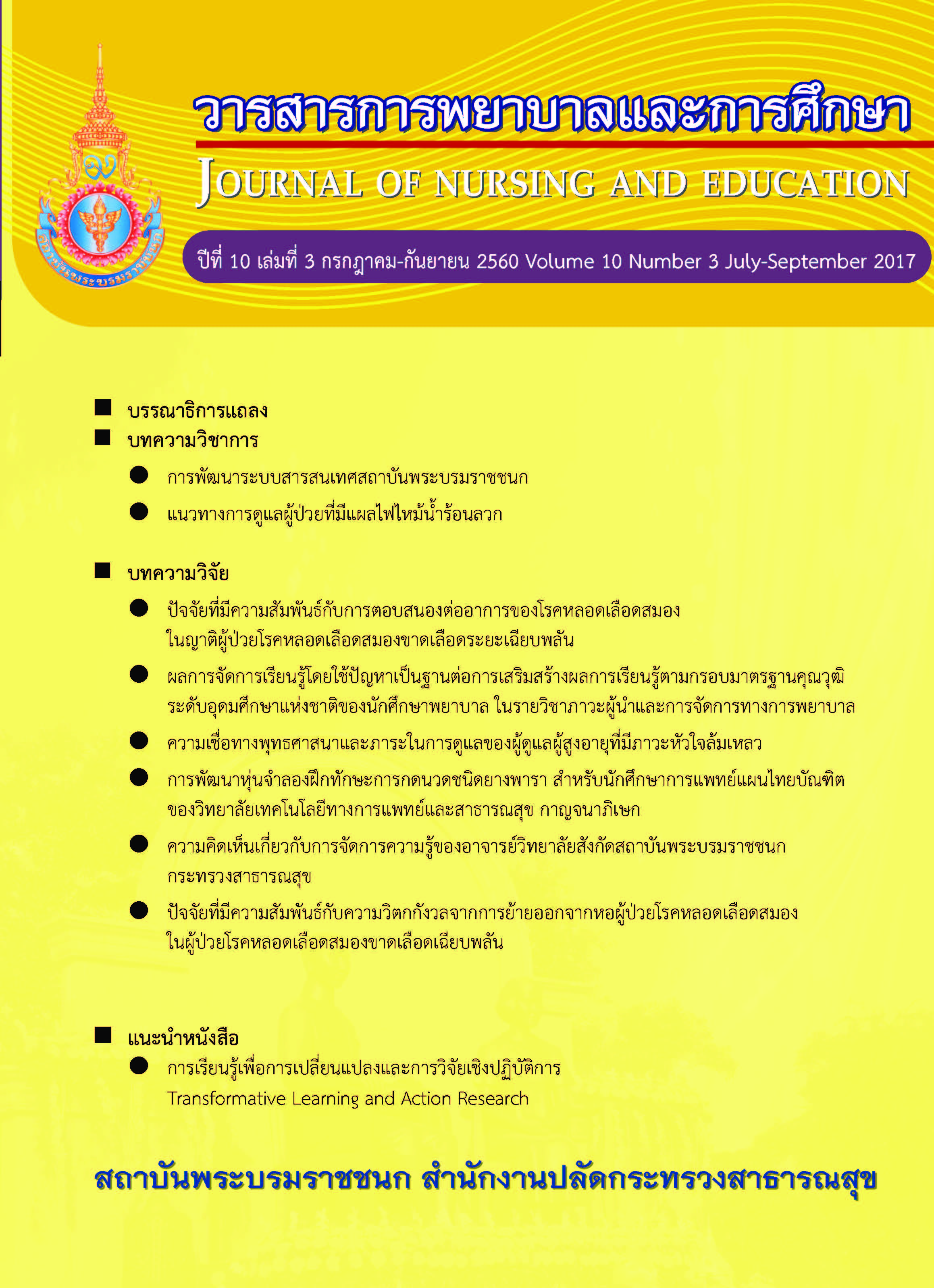การพัฒนาหุ่นจำลองฝึกทักษะการกดนวดชนิดยางพารา สำหรับนักศึกษาการแพทย์แผนไทยบัณฑิตของวิทยาลัยเทคโนโลยี ทางการแพทย์และสาธารณสุข กาญจนาภิเษก
Development of a 3D para rubber model for practicing massage skill of TTM students of Kanchanabhisek institute of Medical and Public Health Technology
บทคัดย่อ
บทคัดย่อ
การวิจัยครั้งนี้เป็นการวิจัยและพัฒนา (Research and Development : R&D) มีวัตถุประสงค์ 1) เพื่อพัฒนาหุ่นจำลองฝึกทักษะการกดนวดสำหรับนักศึกษาการแพทย์แผนไทย 2) เพื่อเพิ่มทักษะการกดนวดระหว่างก่อนกับหลังการใช้หุ่นจำลองและ 3) ประเมินความพึงพอใจในการใช้หุ่นจำลองฝึกทักษะการกดนวดสำหรับนักศึกษาการแพทย์แผนไทยบัณฑิต ของวิทยาลัยเทคโนโลยีทางการแพทย์และสาธารณ สุขกาญจนาภิเษก เครื่องมือที่ใช้ หุ่นจำลองฝึกทักษะการกดนวดชนิดยางพารา แบบวัดทักษะการกดนวดและแบบประเมินความพึงพอใจต่อการใช้หุ่นจำลองเครื่องมือในการวิจัยได้ผ่านการตรวจสอบความตรงตามเนื้อหา ได้ค่าความเชื่อมั่นเท่ากับ 0.93 วิเคราะห์คะแนนเฉลี่ยก่อน – หลัง จากการใช้หุ่นจำลองฝึกทักษะการกดนวดด้วยค่าสถิติ Pair-t-test ความพึงพอใจวิเคราะห์โดยหาค่าเฉลี่ย และส่วนเบี่ยงเบนมาตรฐาน (S.D.)
ผลการศึกษาพบว่า หุ่นจำลองมีลักษณะเป็นหุ่นไหล่ซีกหนึ่งมีขนาดกว้าง19 เซนติเมตรสูง 24 เซนติเมตรสามารถพกพาสะดวก ใช้วัสดุที่ปลอดภัยเนื่องจากวัสดุผลิตจากยางพาราและปูนปลาสเตอร์ประหยัดค่าใช้จ่ายต่อกระบวนการผลิตเนื่องจากต้นทุนการผลิตหุ่นแบบโลหะมีต้นทุนการผลิตที่สูงกว่าหุ่นที่มาจากวัสดุจากยางพารา หุ่นจำลองฝึกทักษะการกดนวดสามารถใช้ประกอบการถ่ายทอดความรู้ ความเข้าใจในการเรียนของนักศึกษาการแพทย์แผนไทยบัณฑิต โดยการลงมือปฏิบัติ เป็นสื่อ 3 มิติประเภทหุ่นจำลองใช้ฝึกทักษะปฏิบัติในการออกทักษะการกดนวดด้วยตนเองมีความอ่อนนุ่ม ผิวสัมผัสราบเรียบ ผลจากการประเมินคุณภาพหุ่นจำลองฝึกทักษะการกดนวด โดยผู้เชี่ยวชาญเห็นว่ามีคุณภาพตามเกณฑ์ ผลการประเมินทักษะในการกดนวดของนักศึกษาการแพทย์แผนไทยบัณฑิตระหว่างก่อนกับหลังการใช้หุ่นจำลองฝึกทักษะการกดนวดแตกต่างกัน อย่างมีนัยสำคัญทางสถิติที่ 0.05 และนักศึกษามีความพึงพอใจต่อหุ่นจำลองฝึกทักษะการกดนวดโดยภาพรวมมีค่าเฉลี่ยเท่ากับ 4.27 ซึ่งอยู่ในระดับมาก
ABSTRACT
This research and development study aimed 1) to develop a para rubber model for practicing massage skills for TTM (Thai Traditional Medicine) students and 2) to compare massage skills of TTM students before and after using the developed model and 3) to study satisfaction level of the students after using the model. The content validity of the tools was confirmed by three professionals. The data collected analyzed using statistical tools including content analysis for data from TTM instructors, paired-t test for pre and post massage skills and mean and standard deviation (SD) for satisfaction level.
The result of this study showed that the para rubber model was designed to imitate human structure as a half human shoulder. The model was 30 cm in width and 30cm in height which was portable. It was developed from the material which was save and economical for manufacturing process. Being a three-dimension (3D) instructional media, the developed model was found to be able to facilitate the practicing and learning Thai massage for TTM students. The texture of the model was soft and smooth. This study demonstrated that the 3D para rubber model was an effective tool resulting a significant difference between massage skill of TTM students before and after using the model at the .05 level of significance. The overall satisfaction level of the subjects was high with the average value of 4.27.
เอกสารอ้างอิง
1. Malithong G . Contemporary Educational Technology. Bangkok: Chulalongkorn University press, 2007. (in Thai)
2. Malithong G. Educational Technology and Innovation. Bangkok: Chulalongkorn University press, 1996. (in Thai)
3. Kansonteiya K . Dog modeling for the great anatomy - Science for undergraduate student’s veterinary science. Dissertation for Master degree of science, Kasetsart University. 1999. (in Thai)
4. Thai Traditional Medicine Development Foundation. The Thai royal court massage. Bangkok: Mohchaoban press; 2005. (in Thai)
5. Thai Traditional Medicine Development Foundation. Foundation for health and development. Bangkok: Mohchaoban press; 2008. (in Thai)
6. Sangprathipthong W. Characteristics and quality assurance of educational measurement instruments. Chulalongkorn University press, 2005. (in Thai)
7. Setalanuchit M. A study of instructional results using modeling models with learning achievement and retention about the central pressure in nursing students is different. Dissertation for Master degree of Medicine. Mahidol University; 1988. (in Thai)
8. Silakorn P. Modeling of transverse human body model for cross-sectional study of topographic anatomy. Dissertation for Master degree of medicine, Mahidol University ; 1992. (in Thai)
9. Kongkong W. Plastic modeling of the human head bone in the teaching of the anatomy of high school diploma students. Dissertation for Master degree of Medicine. Ramkhamhaeng University. 2006. (in Thai)






